Meanwhile, back in Ohio…
I was walking in the woods one day, as I am wont to do, when I came across this fruit on the ground:
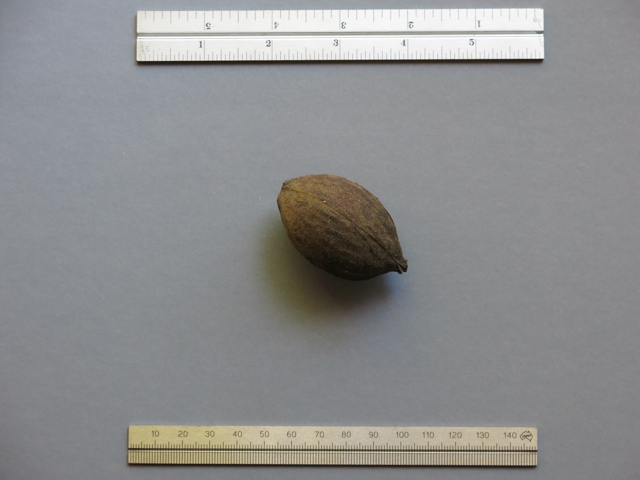
I’ve mentioned previously that I’ve never seen a butternut tree around here, but this looks suspiciously like a butternut (Juglans cinerea). I looked up at the trees over the spot where I found the nut, but there were definitely no butternuts (or black walnuts, either), although there were several hickories.
A typical hickory fruit is more spherical, such as this shagbark hickory (Carya ovata):
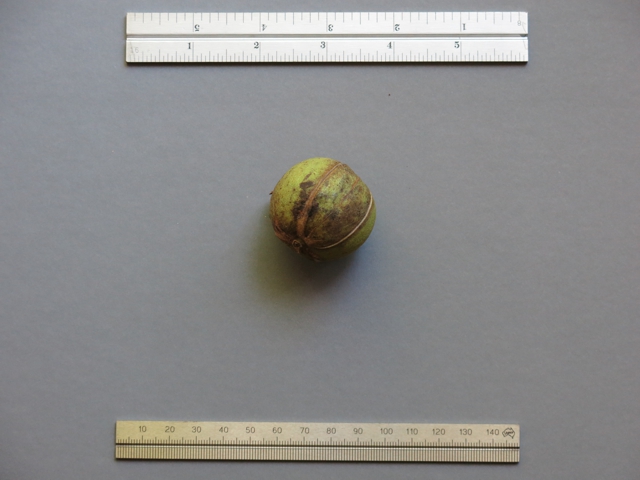
Mockernut (C. tomentosa) fruit are similar, but they’re distinguishable when you open them up:

The mockernut, on the left, has a large kernel surrounded by thin flesh, while the shagbark on the right has a small kernel and very thick flesh.
I opened up the mystery nut, and on the inside it looks very much like a mockernut, albeit aberrantly shaped:
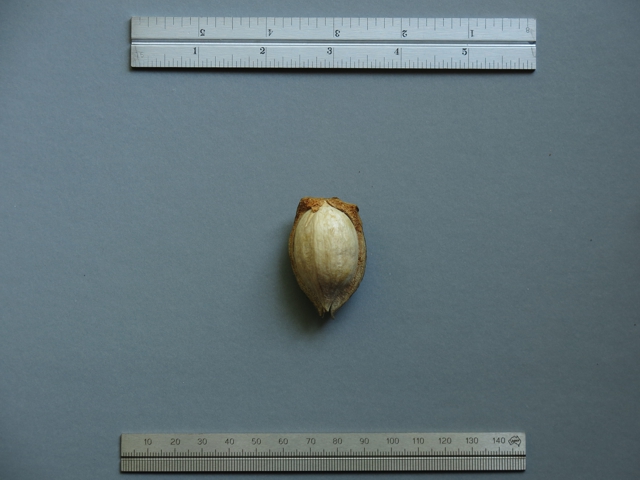
It’s definitely not a butternut, as the shell of a butternut is deeply grooved, much like this black walnut (J. nigra):
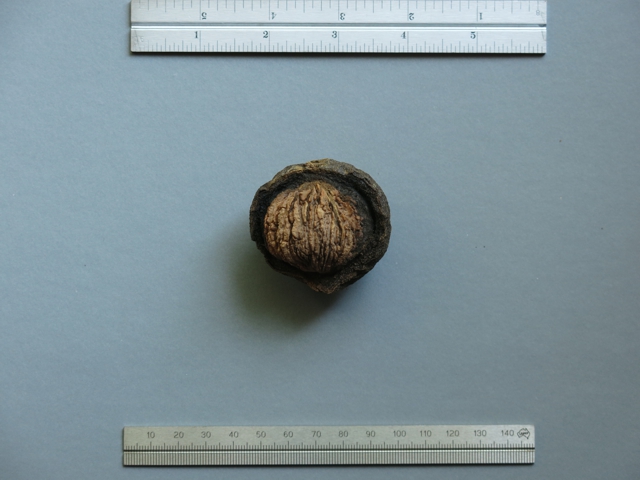
Here’s another hickory; I believe that it is a bitternut (C. cordiformis), but I can’t get near enough to the tree to pick one off and look at it closely:
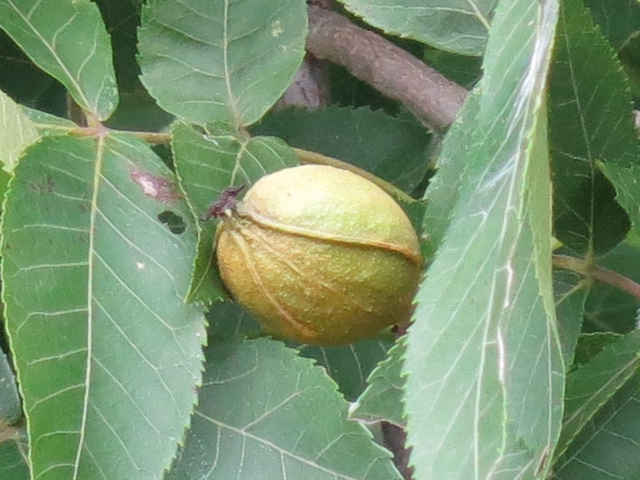
There’s another kind of hickory around here that I didn’t mention back in the June installment, because I hadn’t come across an example. But now I have:
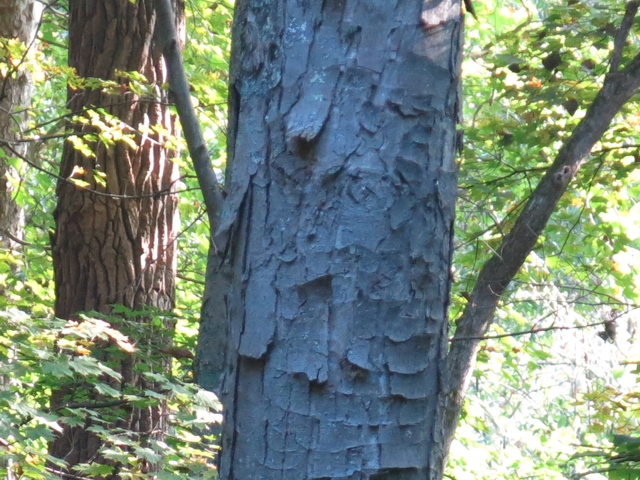
The shellbark hickory (C. laciniosa) has bark that’s peely like shagbark, but in smaller pieces. I probably would have passed right by this tree had I not noticed the fruit. The fruit of the shellbark is round and huge, almost the size of a tennis ball. Unfortunately, this one was standing in a swamp, and I was not willing to search for a fallen nut in the fetid water. (I will only go so far for you, dear reader.)
Other trees setting fruit in August are black cherries (Prunus serotina):
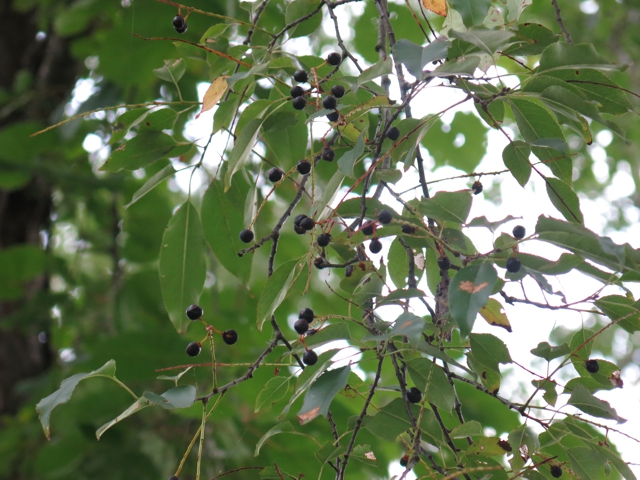
And yellow buckeye (Aesculus flava):
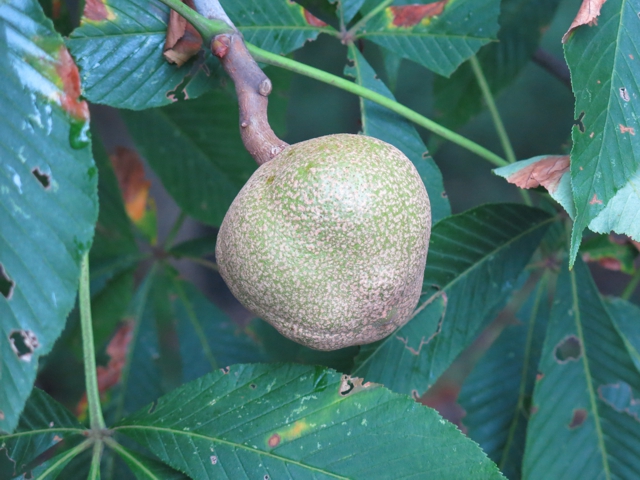
The fruit of Ohio buckeye (A. glabra) is more spherical, and sparsely covered with short spines.
Late summer is mushroom season in the Appalachian forests. There are mushrooms at other times of year, too, but the peak is in July and August. One of the most sought after is the golden chanterelle (Cantharellus cibarius):
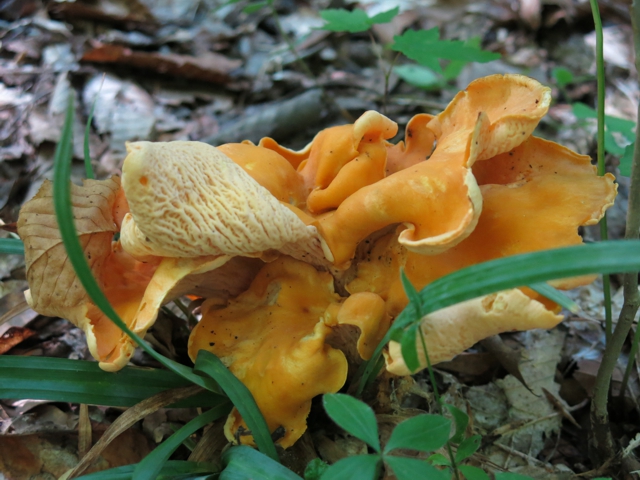
This is one of the few wild mushrooms that I’m willing to pick and eat. There are a few inedible and even poisonous species that are vaguely similar, but a telltale identifying characteristic of the chanterelle is the presence of small ridges, in place of true gills, on the underside of the cap:
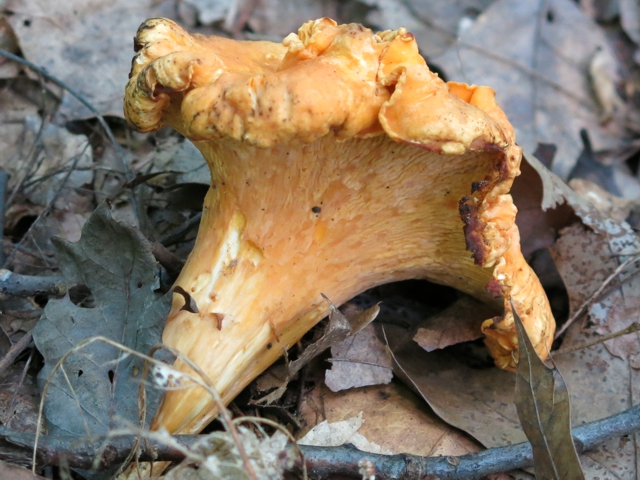
This is a destroying angel (Amanita virosa):
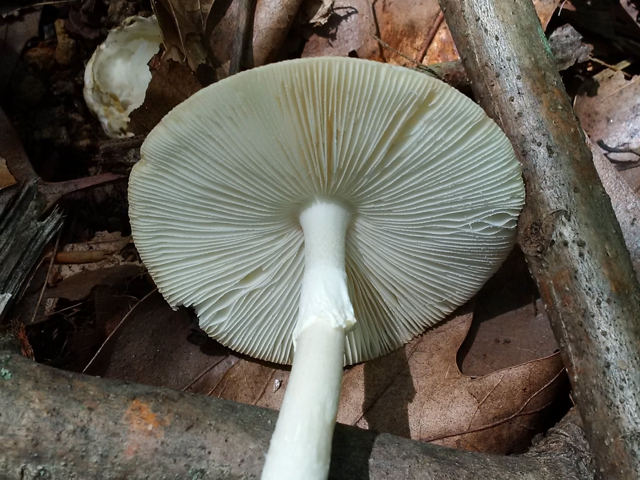
You can probably guess from the name that it’s one you shouldn’t eat. It and its close relatives are the species most often responsible for mushroom-related fatalities. Its toxicity is especially insidious because by the time you experience any symptoms, your liver and kidneys are pretty much gone.
The destroying angel is pure white, but other Amanita mushrooms are not. Like the other members of its genus, there is a distinct “veil” on the stem, and the base of the mushroom appears to emerge from an egg:
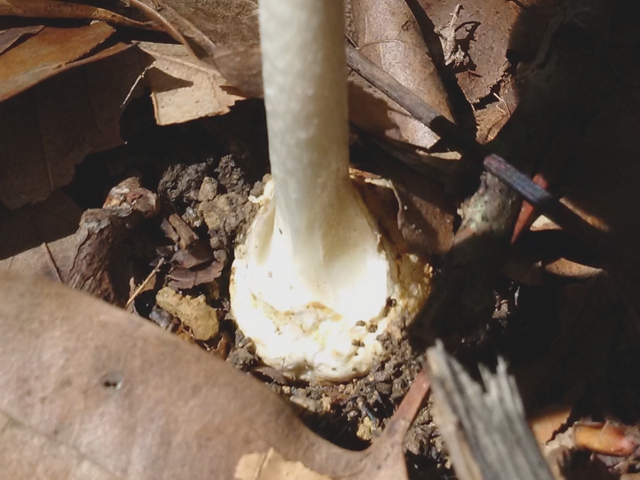
Here’s another veiled mushroom:
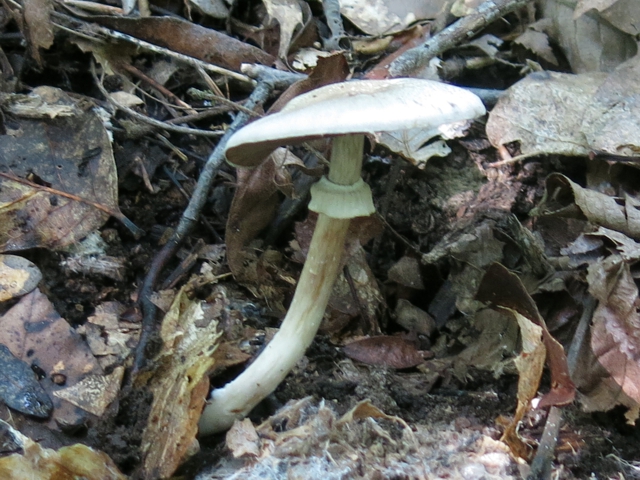
I wasn’t able to figure this one out; maybe Amanita or Lepiota. I don’t think I’ll eat it.
This one is a bolete; I believe that it is Gyroporus castaneus, the chestnut bolete, but I’m not 100% sure:
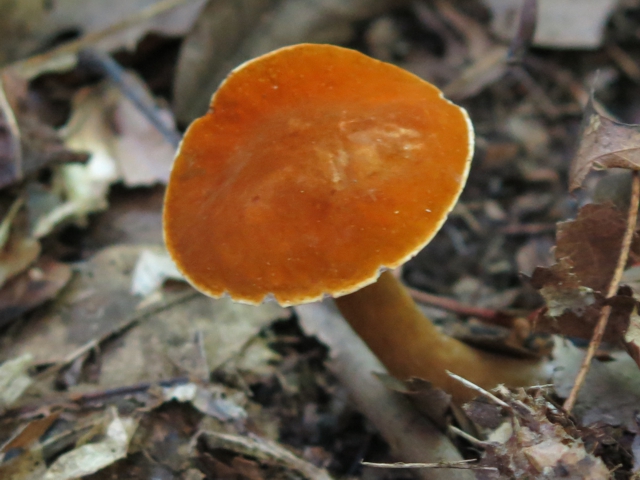
I didn’t get a good photo of the underside, but in place of gills, boletes are covered with tiny, close-packed pores.
Many Russula mushrooms, such as this short-stemmed russula (R. brevipes), won’t kill you but are not particularly good to eat:
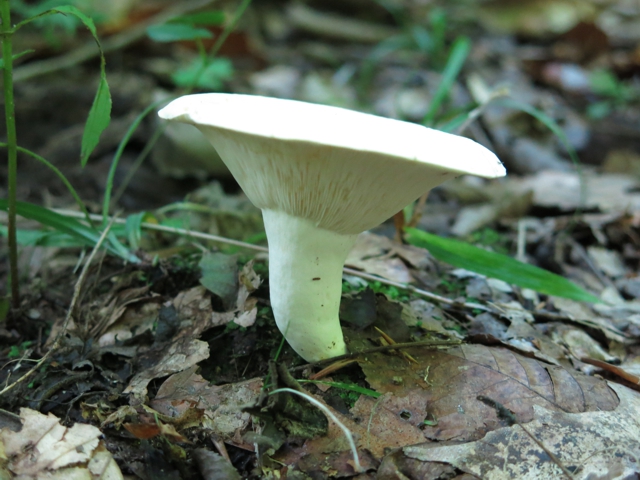
Interestingly, they can become infected by a parasitic fungus, Hypomyces lactifluorum, which causes them to turn bright red, whereupon they’re known as lobster mushrooms. Apparently, in this form they are much better tasting (I’ve never tried), with a seafood-like taste (appropriately enough). I’ve seen lobster mushrooms in these woods before, but couldn’t find any this year.
The stalked scarlet cup (Sarcoscypha occidentalis) is tiny, but is so brightly colored that it’s easy to pick out, growing on fallen twigs on the forest floor:
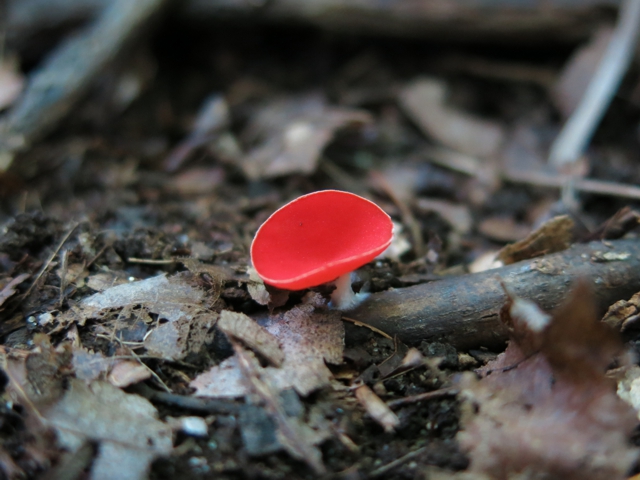
Not all mushrooms look like mushrooms. The jellied false coral (Tremellodendron pallidum) is closely associated with oak trees:
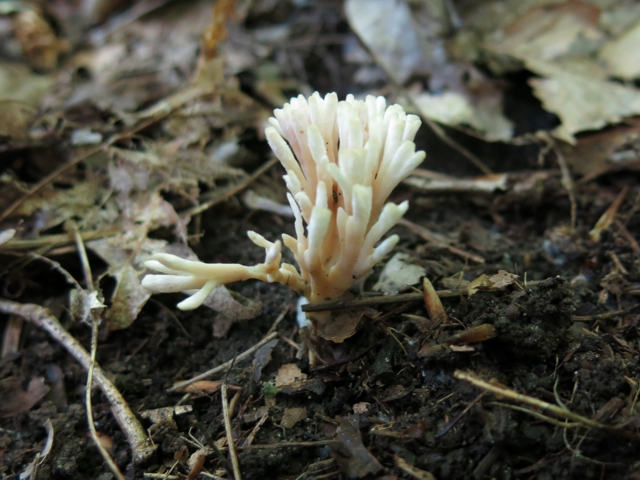
We can’t have a false coral mushroom without also having a true coral mushroom, so here’s a crested coral (Clavulina cristata):

I found these mushrooms growing on some hardwood mulch in my front yard:
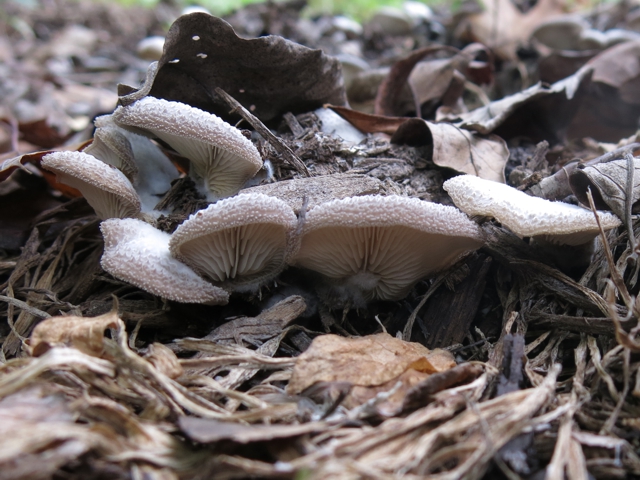
It took quite a bit of research, but I think I’ve correctly identified them as Hohenbuehelia mastrucata, the wooly oyster mushroom.
I’ve avoided writing about grasses, mostly because there just aren’t that many that grow in the woods. They’re also usually pretty hard to tell apart. But one common grass that grows deep in the shade and is easy to identify is eastern bottlebrush grass (Elymus hystrix):

I found this flower growing in my yard:

It’s an orchid, spring lady’s tresses (Spiranthes vernalis). Despite the name, it often blooms in late summer. While researching it online, I discovered that there was no record for this species for Athens County in the USDA PLANTS database, so I submitted photos and other documentation, and now there is.
I took the above photo ten years ago, and I haven’t seen it blooming since. I don’t know if the plant is still around or not. It’s very inconspicuous when it’s not blooming.
After a couple of slow wildflower months, activity begins to pick up again in August. Because it’s still pretty dark in the woods, most woodland-associated wildflowers are found either in open spaces within the woods, or along the margins.
There are many, many species of goldenrod (Solidago), and they can be very tricky to tell apart. One of the earliest to bloom is the aptly-named early goldenrod (S. juncea):

It’s hard to tell from the photo, but this one is easy to identify by its narrow leaves without toothed margins, along with small offshoot leaves that grow out from the bases of the main leaves.
The widespread goldenrod that we see along roadsides and in open fields is tall goldenrod (S. altissima). It’s sometimes called Canada goldenrod, but that name is also used for S. canadensis. You’re probably aware that there are many plants that have been imported from elsewhere into North America, and that have turned out to be extremely invasive. It works both ways, as Canada goldenrod has wreaked havoc in Europe and Asia, even leading to the extinction of several species in China.
The common evening primrose (Oenothera biennis) grows in grassy openings in the woods:

The Carolina horsenettle (Solanum carolinense) is a member of the nightshade family, and shares the same five-petaled “beaked” flowers that all nightshades have:

Look closely, and you can see the thorns covering its stems and the undersides of its leaves. All parts of the plant are poisonous, but the tomato-like fruits are the only part that might kill you.
I’ve mostly let nature take over the yard, and as a result, tall ironweed (Vernonia altissima) has started showing up:

At first, the deer would munch off the leaves before the plants got very far along, but now there are enough of the plants that I get lots of flowers. And it really is tall; this particular plant reaches well above my head.
It’s a stretch to call butterfly milkweed (Aclepias tuberosa) a woodland wildflower, but it’s one of my favorites, so you get a photo anyway:

– Steve Schafer